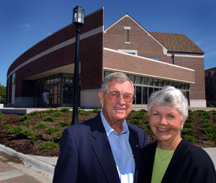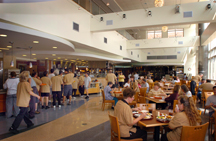
| RELATED INFO |
| • Purdue University Residences |
| • Purdue's executive vice president and treasurer to retire |
October 19, 2004
Food court named in honor of Fords
Purdue dedicates itself to the future of college dining
WEST LAFAYETTE, Ind. – A delicious revolution is under way on college campuses across the nation. Institutional starchy foods and the one-menu-fits-all regimen have given way to dining facilities that offer choices from traditional to gourmet, healthy to hearty, cooked on demand.

|
At Purdue University, which dedicated its third new-style dining court today (Tuesday, Oct. 19), the transformation is changing the way students eat.
"Students who eat here find it's not their fathers' college cafeteria anymore," said Sarah Johnson, director of dining services for Purdue University Residences. "In their parents' days, there was limited menu choice. Mealtime was short and rigid, and they had to eat in the housing unit to which they were assigned. Now, the focus is on quality and choices – in food, hours, locations.
"Our students are accustomed to eating out far more than their parents ever were, and they expect to be treated like customers. They also are more health conscious. Our new dining courts are overwhelmingly popular with them."
The $18 million dining court on Stadium Avenue will be named for a couple who helped make it possible: Purdue executive vice president and treasurer emeritus Frederick R. Ford and his wife, Mary.

|
The naming is subject to the approval of the Purdue Board of Trustees.
"Fred Ford's financial leadership at Purdue – especially his 24 years as executive vice president and treasurer – helped us build one of the largest and best residence hall systems in the country," said Purdue President Martin C. Jischke. "That management was crucial to our halls and dining facilities, which are completely self-supporting. And Mary was always there to support him and Purdue."
Much has changed in the 68 years since Fred Ford was born in Kentland, Ind., and the 50 years since he enrolled at Purdue, fresh out of high school and off the family farm in Brook, Ind.
"It's amazing to me all the changes, all the options students have now," Ford said. "Under the leadership of former Vice President Ron Fruitt and current Vice President John Sautter, I think the people in residence halls have done a magnificent job in adapting over the years to accommodate student needs and tastes.
"When I became vice president and treasurer in 1974, the vice president of housing and food services, Jack Smalley, even then was calling these facilities 'residence halls' instead of dorms. Jack said these should be more than places where people hang their hat, more than a bed and a meal card. They should be residences in a supportive community with activities and programs.
"That's what we strove for at Purdue. It's rewarding to see that philosophy continues."
The two-story Fred and Mary Ford Dining Court on the corner of Stadium Avenue and Russell Street, just south of Ross-Ade Stadium, has seating for 800 and is open to students, faculty, staff and the community. Earhart and Hillenbrand dining courts opened after remodeling in the fall of 2003. Windsor and Wiley dining courts, which will be created as additions to the existing buildings, are slated to open by 2005 and 2007, respectively.
"These dining services are so popular, it's not uncommon for Ford, Earhart and Hillenbrand to serve 16,000 people in a day – 89 percent of our total," Johnson said. "Students come from all over campus to these new courts in appreciation of what we have to offer."
The Ford Dining Court – University Residences' first freestanding dining court – is a colorful marketplace with eight venues under one roof, Johnson added.
Selections include: hearth-baked pizzas; Southeast Asian-style dishes cooked in woks; home-style entrees, hot vegetables and carved meats; greens, fresh vegetables, fruit and soups; fried and grilled foods; sliced meat and cheese; international wraps and made-to-order entrée salads; Black Angus hamburgers, oven smoked ribs and grilled chicken breasts; fresh waffles; and a wide variety of desserts including fresh-baked pies, self-serve hand-dipped and soft ice cream and the court's signature cookies that measure about six inches across.
Large windows let in sunlight, and an abundance of glass adds a light touch surrounded by 28-foot-tall ceilings, ceramic wall tiles and muted carpeting. Wood and limestone wainscoting, maple furniture, modern chandeliers, granite countertops and artwork complete the picture. Diners can choose to sit at tables and chairs, barstools, booths and banquettes.
Ford was a Boilermaker sophomore in mechanical engineering who hoped to someday design better farm equipment when, in 1956, he met Mary Harrison, who had come to Purdue from the area between Hillsdale and Clinton in Vermillion County, Ind. Three years later, on a spring morning, she earned her bachelor's degree in home economics; that evening, they were married.
She went on to earn a master's degree and focused on the school and community activities of their three children – Lynne, Steven and Katherine. He worked his way through a doctorate in what was then Purdue's fledgling Krannert School of Management, simultaneously launching his career in business services at Purdue.
Mary Ford's School of Home Economics became today's School of Consumer and Family Sciences, but her support continued. She has been active with its alumni association, and in recognition, Stone Hall's popular meeting room, Stone Cellar, was named the Mary Harrison Ford Conference Room. She remains active at the national level with her sorority, Alpha Chi Omega, having served on its board of directors and as chairman of its foundation.
Both she and her husband are involved with the Museum at Prophetstown in Tippecanoe County, she as a member of the board of directors and he on the finance committee. Fred Ford also is on the investment committees at the Westminster Foundation and Central Presbyterian Church, where he is chairman.
Ford served under three presidents and one interim president.
"I had the privilege of serving under presidents Frederick L. Hovde, Arthur G. Hansen and Steven C. Beering. Interim president John W. Hicks III was my prime mentor," Fred Ford said. "I was also blessed with outstanding boards of trustees during my tenure. They demanded excellence in all we did."
He won numerous awards during his career at Purdue, including the highest honor given by the National Association of College and University Business Officers for making Purdue's "financial operation a model of efficiency and integrity." The association noted several of Ford's innovations, among them: business administrators based in academic and operating units; various training programs for supervisors as well as clerical and service staff; use of tax-exempt commercial paper for financing major capital programs; a computerized cash-management investment system; a 10-year physical plant repair and rehabilitation program; and implementation of employee involvement groups in participative management.
"We worked hard, we were creative and we also were fortunate," Ford said. "When I started in the treasurer's job in 1974, the Dow was at 700; when I retired in 1998, it was at 11,000."
Ford also oversaw financing and construction of more than $400 million in major construction projects and $200 million in major repair and renovation projects, including the Hansen Life Sciences Building; the Beering Hall of Liberal Arts and Education; the power plant expansion; Hillenbrand Hall, a student residence hall; major expansions to the engineering, veterinary medicine and athletic complexes; and a new food science and biotechnology complex.
Other landmark projects completed during Ford's tenure include construction of a new bell tower and three outdoor malls – the Purdue Mall, Founder's Park and Academy Park. He also oversaw a telecommunications project to rewire the campus.
Ford also served as treasurer of the Indiana University-Purdue University Foundation at Fort Wayne, vice president and treasurer of the Purdue Academic Facilities Foundation, trustee member of the Purdue Research Foundation and treasurer of the Purdue Foundation.
He received an honorary doctorate from Krannert in 1998 and upon retirement was awarded the title executive vice president and treasurer emeritus.
Scholer Corp, of Lafayette, Ind., is the dining court architect. Kettlehut Construction Co. of Lafayette, Ind., is the general contractor. Ricca NewMark Design, of Denver, Colo., is the interior designer.
Regular hours will be weekdays, breakfast from 6:30-9:30 a.m.; lunch from 11a.m. to 2 p.m.; and dinner from 5-8:30 p.m. Weekend hours are: Saturday, breakfast from 8-9:30 a.m., and lunch and dinner from 11 a.m. to 7 p.m.; Sunday, breakfast and lunch from 8 a.m. to 2 p.m.
The dining court dedication is part of a 10-day celebration that focuses on ways Purdue is improving education and helping the state of Indiana as part of its strategic plan and $1.3 billion fund-raising campaign.
Writers: Jeanne Norberg (765) 494-2084, jnorberg@purdue.edu
Reni Winter, (765) 496-3133, rwinter@purdue.edu
Sources: Sarah Johnson, (765) 494-1000, scjohnson@purdue.edu
Martin C. Jischke, (765) 494-9708
Fred and Mary Ford, (765) 463-2037
Purdue News Service: (765) 494-2096; purduenews@purdue.edu
Note to Journalists: Broadcasters who would like video or b-roll should contact Jesica Webb, (765) 494-2079, jwebb@purdue.edu.
PHOTO CAPTION
Frederick R. Ford and his wife, Mary, stand in front of the university's first freestanding dining court, which was named in their honor today (Tuesday, Oct. 19). The Fred and Mary Ford Dining Court, at Russell Street and Stadium Avenue, is the third of five being constructed at Purdue to provide contemporary dining options for students, faculty, staff and the public. Frederick Ford is Purdue's emeritus executive vice president and treasurer. (Purdue News Service photo/Dave Umberger)
PHOTO CAPTION:
Purdue University Residences staff members were the first to sample the fare when the Stadium Avenue Dining Court opened in August. The dining court, located at the intersection of University Street and Stadium Avenue, features marketplace-style dining with 12,750 feet of space and seating for 800. (Purdue Service Photo/Dave Umberger)
To the News Service home page